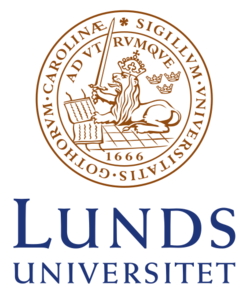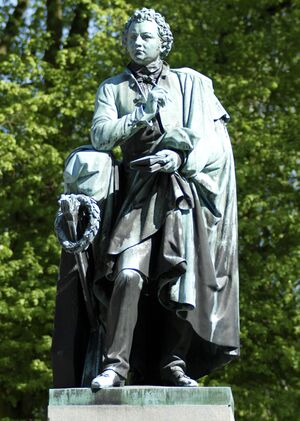Lund University
(University) | |
|---|---|
 | |
| Abbreviation | LU |
| Motto | Ad utrumque |
| Formation | 1666 |
| Headquarters | Lund, Sweden |
| Type | Public research university |
| Traditionally very upper class environment | |
Lund University (Template:Lang-sv) is a public university in Sweden and one of northern Europe's oldest universities. The university is located in the city of Lund in the province of Scania, Sweden. It arguably traces its roots back to 1425, when a Franciscan studium generale was founded in Lund. After Sweden won Scania from Denmark in the 1658 Treaty of Roskilde, the university was officially founded in 1666 on the location of the old studium generale next to Lund Cathedral.
Lund University has nine faculties, with additional campuses in the cities of Malmö and Helsingborg, with 40,000 students in 270 different programmes and 1,300 freestanding courses. The university has some 600 partner universities in nearly 70 countries and it belongs to the League of European Research Universities as well as the global Universitas 21 network. Lund University is consistently ranked among the world's top 100 universities.[1][2]
Two major facilities for materials research are in Lund University: MAX IV, a synchrotron radiation laboratory – inaugurated in June 2016, and European Spallation Source (ESS), a new European facility that will provide up to 100 times brighter neutron beams than existing facilities today, to be opened in 2023.[3]
The university centers on the Lundagård park adjacent to the Lund Cathedral, with various departments spread in different locations in town, but mostly concentrated in a belt stretching north from the park connecting to the university hospital area and continuing out to the northeastern periphery of the town, where one finds the large campus of the Faculty of Engineering.
20th century – present
In the early 20th century, the university had a student population as small as one thousand, consisting largely of upper-class pupils training to become civil servants, lawyers and doctors. In the coming decades, it started to grow significantly until it became one of the country's largest. In 1964 the social sciences were split from the Faculty of Humanities. Lund Institute of Technology was established in 1961 but was merged with Lund University eight years later.
In recent years, Lund University has been very popular among applicants to Swedish higher education institutions, both nationally[4] and internationally.[5][6] For studies starting in autumn 2012, Lund received 11,160 foreign master's applications from 152 countries, which was roughly one third of all international applications to Swedish universities.
Research centres
The university is also organised into more than 20 institutes and research centres,[7] such as:
- Lund University Centre for Sustainability Studies (LUCSUS)
- Biomedical Centre
- Centre for Biomechanics
- Centre for Chemistry and Chemical Engineering - Kemicentrum
- Centre for East and South-East Asian Studies
- Centre for European Studies
- Centre for Geographical Information Systems (GIS Centrum)
- Centre for Innovation, Research and Competence in the Learning Economy (CIRCLE)
- Center for Middle Eastern Studies at Lund University
- Centre for Molecular Protein Science
- Centre for Risk Analysis and Management (LUCRAM)
- International Institute for Industrial Environmental Economics at Lund University (IIIEE)
- Lund Functional Food Science Centre
- Lund University Diabetes Centre (LUDC)
- MAX lab - Accelerator physics, synchrotron radiation and nuclear physics research
- Pufendorf Institute
- Raoul Wallenberg Institute of Human Rights and Humanitarian Law
- Swedish South Asian Studies Network
Alumni on Wikispooks
| Person | Born | Died | Nationality | Summary | Description |
|---|---|---|---|---|---|
| Klas Böök | 10 March 1909 | 5 January 1980 | Sweden | Diplomat Central banker | Swedish diplomat and economist who was Governor of the Swedish National Bank from 1948 to 1951 |
| Ingvar Carlsson | 9 November 1934 | Politician Economist | Took over as Sweden's PM upon the assassination of Olof Palme. | ||
| Tage Erlander | 13 June 1901 | 21 June 1985 | Sweden | Politician | Swedish PM for 25 years |
| Kjell-Olof Feldt | 18 August 1931 | Sweden | Politician | Social Democrat Minister of Finance who attended Bilderberg and initiated large neoliberal changes. | |
| Pehr G. Gyllenhammar | 8 April 1935 | Sweden | Deep state actor Businessperson | Swedish CEO, European Round Table of Industrialists, Banque Rothschild, with deep state ties | |
| Peter Gøtzsche | 26 November 1949 | Denmark | Doctor Science/Dissident | ||
| Jonas Hafström | 27 February 1948 | Sweden | Diplomat | ||
| Lars Jonung | 11 September 1944 | Sweden | Economist | Swedish economist who attended the 1991 Bilderberg | |
| Annie Lööf | 16 July 1983 | Sweden | Politician | Swedish politician who attended the 2017 Bilderberg meeting and was a member of the Trilateral Commission. From a minor party, but asked to form a government in 2018, which did not succeed. | |
| Sven Moberg | 19 November 1919 | 4 October 1994 | Sweden | Politician | Attended the 1970 Bilderberg as Swedish Assistant Education Minister, formerly under Minister Olof Palme |
| Bertil Ohlin | 23 April 1899 | 3 August 1979 | Sweden | Politician Economist | Swedish economist and politician who attended 3 Bilderbergs up to the 1962 Bilderberg |
| Karin Olofsdotter | 16 June 1966 | Sweden | Diplomat | Swedish diplomat and Swedish Ambassador to the United States | |
| Mauricio Rojas | 28 June 1950 | Sweden Chile | Politician Economist | Chilean born Swedish politician. Attended the 1999 Bilderberg meeting as leader of the neoliberal think tank Timbro. Prominent in immigrant integration questions for the Liberal Party. | |
| Anders Tegnell | 17 April 1956 | Sweden | Doctor | State epidemiologist of Sweden during COVID. | |
| Michael Treschow | 22 April 1943 | Sweden | Businessperson Reserve officer | One of the most influential people in Swedish business. Wallenberg sphere. |
References
- ↑ http://www.lunduniversity.lu.se/about/about-lund-university/university-world-rankings
- ↑ http://www.topuniversities.com/university-rankings/world-university-rankings/2015%7Ctitle=QS World University Rankings - 2015
- ↑ https://europeanspallationsource.se/ess-mandate
- ↑ http://www.scb.se/statistik/_publikationer/UF0513_2009A01_BR_A40BR1002.pdf
- ↑ https://web.archive.org/web/20121105044724/http://www.lunduniversity.lu.se/o.o.i.s?id=24890&news_item=5781
- ↑ https://web.archive.org/web/20160124150445/http://blogs.sweden.se/study/2011/02/03/decrease-in-international-applicants-to-swedish-universities/
- ↑ https://web.archive.org/web/20140824190305/http://www.lunduniversity.lu.se/o.o.i.s/24893
